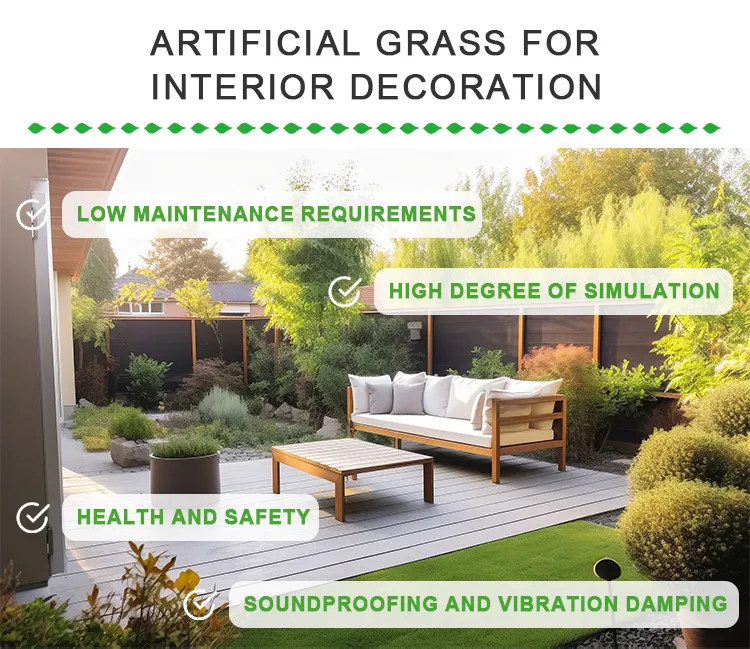
- Afrikaans
- Arabic
- Belarusian
- Bengali
- Czech
- Danish
- Dutch
- English
- Esperanto
- Estonian
- Finnish
- French
- German
- Greek
- Hindi
- Hungarian
- Icelandic
- Indonesian
- irish
- Italian
- Japanese
- kazakh
- Rwandese
- Korean
- Kyrgyz
- Lao
- Latin
- Latvian
- Malay
- Mongolian
- Myanmar
- Norwegian
- Persian
- Polish
- Portuguese
- Romanian
- Russian
- Serbian
- Spanish
- Swedish
- Tagalog
- Tajik
- Thai
- Turkish
- Turkmen
- Ukrainian
- Urdu
- Uighur
- Uzbek
- Vietnamese
artificial grass is it good for dogs
Dec . 19, 2024 12:17 Back to list
Is Artificial Grass Good for Dogs? An In-Depth Analysis
As pet owners increasingly seek the best environments for their furry friends, the discussion around the suitability of artificial grass for dogs has gained significant attention. With its growing popularity in residential yards, dog parks, and commercial spaces, artificial turf presents both benefits and challenges for dog owners. This article explores the pros and cons of artificial grass when it comes to accommodating our canine companions.
Benefits of Artificial Grass for Dogs
1. Durability and Longevity One of the standout features of artificial grass is its durability. Unlike natural grass, which can easily become patchy or muddy after heavy use, synthetic turf is designed to withstand the wear and tear caused by canine activities. It won’t wear thin from digging, running, or playing, making it a viable long-term investment for dog owners.
2. Low Maintenance Natural grass requires regular mowing, watering, and fertilizing, which can be time-consuming and costly. In contrast, artificial grass requires minimal maintenance. Pet owners will appreciate the convenience of not having to worry about grass growth, weeds, or mud. A quick rinse with water is usually enough to keep the surface clean and odor-free.
3. Cleanliness Dog owners often face the challenge of keeping their yards clean. With artificial turf, the risk of muddy paws is significantly reduced. Many varieties of artificial grass are designed with drainage systems that allow urine and other liquids to pass through easily, preventing the formation of unpleasant odors and puddles. This can create a more hygienic space for both pets and their owners.
4. Allergy Management Some dogs suffer from allergies triggered by pollen and certain grass types. Artificial grass provides a hypoallergenic alternative, allowing allergy-prone pets to enjoy outdoor time without fear of irritants. This can lead to a better quality of life for sensitive pets, helping them enjoy the outdoors without discomfort.
5. Consistent Surface For older dogs or those with joint issues, the consistent surface of synthetic grass can be easier and safer to navigate than uneven or muddy natural lawns. This can make a significant difference in their mobility and comfort during outside playtime.
artificial grass is it good for dogs

Challenges of Artificial Grass for Dogs
1. Heat Absorption One of the major concerns with artificial grass is its ability to retain heat. On a sunny day, synthetic turf can become quite hot, potentially making it uncomfortable for pets to walk or play on. To address this issue, some manufacturers offer heat-resistant products or recommend regular watering of the turf to cool it down.
2. Chemical Concerns While many types of artificial grass are designed to be pet-friendly, it is crucial for owners to ensure that the materials used are non-toxic. Some lower-quality synthetic turfs may contain harmful chemicals that could pose safety risks to pets. It is advisable to do thorough research and select products specifically labeled as safe for pets before installation.
3. Potty Training Challenges For puppies or dogs still learning where to relieve themselves, it may take some time to adjust to artificial grass. Unlike natural grass, which gives off a distinct scent and texture, pets may need some encouragement to recognize artificial turf as a suitable potty area. Training pads or patches of natural grass can help facilitate this transition.
4. Initial Cost The installation of artificial grass can come with a hefty price tag. While it offers long-term savings in terms of maintenance and water costs, the upfront investment may not be feasible for all pet owners. It’s essential to weigh the advantages against the initial costs before making a decision.
Conclusion
Artificial grass can be a fantastic option for dog owners looking for a functional, low-maintenance alternative to natural turf. It offers significant benefits such as durability, ease of cleaning, and hypoallergenic properties. However, potential challenges like heat retention and initial costs should also be carefully considered. By researching and selecting high-quality, pet-friendly options, dog owners can create a safe and enjoyable outdoor space that both they and their pets can love. Ultimately, the decision will depend on the specific needs of the pet and the preferences of the owner.
-
The Benefits of Artificial Turf for Indoors
NewsJul.15,2025
-
How Artificial Grass Suppliers Ensure Quality Products
NewsJul.15,2025
-
Artificial Grass and Pets: A Space for Relaxation
NewsJul.08,2025
-
Balcony & Outdoor Decoration with Artificial Grass
NewsJul.08,2025
-
Best Indoor Artificial Grass for Home
NewsJul.07,2025
-
Best Pet Turf for Dogs: Safe & Durable Artificial Grass Options
NewsJul.07,2025
Products categories









